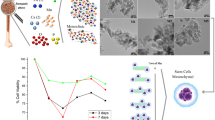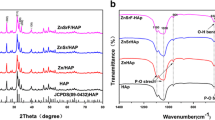Abstract
Three defect-related luminescent hydroxyapatite (HAP) particles, S1, S2, and S3, with different morphologies (the samples S1 and S2 are nanorods with diameters of 25 nm and lengths of 30 and 100 nm, respectively; sample S3 is bur-like microspheres with diameters of 5–6 μm) were synthesized, and their biocompatibility was investigated by MTT, reactive oxygen species (ROS), interleukin-6 (IL-6), comet, and hemolysis assays. The results indicated that all samples were stable in cell culture medium and did not induce the synthesis of proinflammatory cytokine IL-6 or result in hemolysis. It was found that samples S1 and S3 inhibited osteoblast (OB) viability at concentrations of 5, 10, 20, 40, and 80 μg/mL for 24, 48, and 72 h. Sample S2 had no effect on the viability of OB at all tested concentrations for 24 and 48 h, but the viability of OB was increased at concentrations of 20, 40, and 80 μg/mL for 72 h. Samples S1 and S3 could increase the level of cellular ROS; sample S2 had no effect on the level of cellular ROS at a concentration of 20 μg/mL for 48 h. Although samples S1 and S3 induced significant DNA damage, sample S2 could not cause significant DNA damage at a concentration of 20 μg/mL for 72 h. The results suggest that longer nanorod HAP can show excellent biocompatibility and therefore may find potential applications in biomedical fields.







Similar content being viewed by others
References
Budiraharjo R, Neoh KG, Kang ET (2012) Hydroxyapatite-coated carboxymethyl chitosan scaffolds for promoting osteoblast and stem cell differentiation. J Colloid Interf Sci 366:224–232
Qi C, Zhu YJ, Lu BQ et al (2013) Hydroxyapatite hierarchically nanostructured porous hollow microspheres: rapid, sustainable microwave-hydrothermal synthesis by using creatine phosphate as an organic phosphorus source and application in drug delivery and protein adsorption. Chem Eur J 19:5332–5341
Ashokan A, Menon D, Nair S et al (2010) A molecular receptor targeted, hydroxyapatite nanocrystal based multi-modal contrast agent. Biomaterials 31:2606–2616
Li D, Liang Z, Chen J et al (2013) AIE luminogen bridged hollow hydroxyapatite nanocapsules for drug delivery. Dalton Trans 42:9877–9883
Chen F, Lam WM, Lin CJ et al (2007) Biocompatibility of electrophoretical deposition of nanostructured hydroxyapatite coating on roughen titanium surface : in vitro evaluation using mesenchymal stem cells. J Biomed Mater Res B Appl Biomater 82:183–191
Hu Q, Tan Z, Liu Y et al (2007) Effect of crystallinity of calcium phosphate nanoparticles on adhesion, proliferation, and differentiation of bone marrow mesenchymal stem cells. J Mater Chem 17:4690–4698
Cai L, Guinn AS, Wang S (2011) Exposed hydroxyapatite particles on the surface of photo-crosslinked nanocomposites for promoting MC3T3 cell proliferation and differentiation. Acta Biomater 7:2185–2199
Quan R, Yang D, Wu X et al (2008) In vitro and in vivo biocompatibility of graded hydroxyapatite–zirconia composite bioceramic. J Mater Sci Mater Med 19:183–187
Naziroğlu M (2007) New molecular mechanisms on the activation of TRPM2 channels by oxidative stress and ADP-ribose. Neurochem Res 32:1990–2001
Naziroglu M, Karaoğlu A, Aksoy AO (2004) Selenium and high dose vitamin E administration protects cisplatin-induced oxidative damage to renal, liver and lens tissues in rats. Toxicology 195:221–230
Turkez H, Yousef MI, Sönmez E et al (2014) Evaluation of cytotoxic, oxidative stress and genotoxic responses of hydroxyapatite nanoparticles on human blood cells. J Appl Toxicol 34:373–379
Sun JS, Liu HC, Chang WH et al (1998) Influence of hydroxyapatite particle size on bone cell activities: an in vitro study. J Biomed Mater Res 39:390–397
Xu Z, Liu C, Wei J et al (2012) Effects of four types of hydroxyapatite nanoparticles with different nanocrystal morphologies and sizes on apoptosis in rat osteoblasts. J Appl Toxicol 32:429–435
Mandel S, Tas AC (2010) Brushite (CaHPO4 · 2H2O) to octacalcium phosphate (Ca8(HPO4)2(PO4)4 · 5H2O) transformation in DMEM solutions at 36.5 °C. Mater Sci Eng C 30:245–254
Ducheyne P, Radin S, King L (1993) The effect of calcium phosphate ceramic composition and structure on in vitro behavior. I. dissolution. J Biomed Mater Res 27:25–34
Zhang C, Lin J (2012) Defect-related luminescent materials: synthesis, emission properties and applications. Chem Soc Rev 41:7938–7961
Zhang C, Yang J, Quan Z et al (2009) Hydroxyapatite nano- and microcrystals with multiform morphologies: controllable synthesis and luminescence properties. Cryst Growth Des 9:2725–2733
Sashidhara KV, Kumar M, Khedgikar V et al (2013) Discovery of coumarin–dihydropyridine hybrids as bone anabolic agents. J Med Chem 56:109–122
Swarnkar G, Sharan K, Siddiqui JA et al (2012) A naturally occurring naringenin derivative exerts potent bone anabolic effects by mimicking oestrogen action on osteoblasts. Br J Pharmacol 165:1526–1542
Park EJ, Yi J, Chung KH et al (2008) Oxidative stress and apoptosis induced by titanium dioxide nanoparticles in cultured BEAS-2B cells. Toxicol Lett 180:222–229
Zhou C, Pan W, Wang XP et al (2012) Artesunate induces apoptosis via a Bak-mediated caspase-independent intrinsic pathway in human lung adenocarcinoma cells. J Cell Physiol 227:3778–3786
Sousa C, Fernandes F, Valentão P et al (2012) Brassica oleracea L. var. costata DC and Pieris brassicae L. aqueous extracts reduce methyl methanesulfonate-induced DNA damage in V79 hamster lung fibroblasts. J Agric Food Chem 60:5380–5387
Lin YS, Haynes CL (2010) Impacts of mesoporous silica nanoparticle size, pore ordering, and pore integrity on hemolytic activity. J Am Chem Soc 132:4834–4842
Hornez JC, Chai F, Blanchemain N et al (2007) Biocompatibility improvement of pure hydroxyapatite (HA) with different porosity. Key Eng Mater 330:927–930
Khandhar AP, Ferguson RM, Krishnan KM (2011) Monodispersed magnetite nanoparticles optimized for magnetic fluid hyperthermia: implications in biological systems. J Appl Phys 109:07B310
Tanimoto Y, Shibata Y, Kataoka Y et al (2008) Osteoblast-like cell proliferation on tape-cast and sintered tricalcium phosphate sheets. Acta Biomater 4:397–402
Shi Z, Huang X, Cai Y et al (2009) Size effect of hydroxyapatite nanoparticles on proliferation and apoptosis of osteoblast-like cells. Acta Biomater 5:338–345
Hyun MS, Hur JM, Mun YJ et al (2010) BBR induces apoptosis in HepG2 cell through an Akt-ASK1-ROS-p38MAPKs-linked cascade. J Cell Biochem 109:329–338
Ishimi Y, Miyaura C, Jin CH et al (1990) IL-6 is produced by osteoblasts and induces bone resorption. J Immunol 145:3297–3303
Axmann R, Böhm C, Krönke G et al (2009) Inhibition of interleukin-6 receptor directly blocks osteoclast formation in vitro and in vivo. Arthritis Rheum 60:2747–2756
Steiner G, Tohidast-Akrad M, Witzmann G et al (1999) Cytokine production by synovial T cells in rheumatoid arthritis. Rheumatology 38:202–213
Stanic V, Janackovic D, Dimitrijevic S et al (2011) Synthesis of antimicrobial monophase silver-doped hydroxyapatite nanopowders for bone tissue engineering. Appl Surf Sci 257:4510–4518
Acknowledgments
This research was supported by the National Natural Science Foundations of China (21001038, 31470961, 21301046 and 51302062), the Research Fund for the Doctoral Program of Higher Education of China (20111301110004, 20131301120004), Hebei Province “Hundred Talents Program” (BR2-202), the China Postdoctoral Science Foundation (2013 M530119), the Natural Science Foundation of Hebei Province (B2012201074), the Outstanding Youth Fund Project (Y2012007) of Hebei Education Department, Training Program for Innovative Research Team, China Postdoctoral Science Foundation (2014T70226) and Leading Talent in Hebei Province University (LJRC024).
Author information
Authors and Affiliations
Corresponding authors
Rights and permissions
About this article
Cite this article
Dai, C., Duan, J., Zhang, L. et al. Biocompatibility of Defect-Related Luminescent Nanostructured and Microstructured Hydroxyapatite. Biol Trace Elem Res 162, 158–167 (2014). https://doi.org/10.1007/s12011-014-0151-0
Received:
Accepted:
Published:
Issue Date:
DOI: https://doi.org/10.1007/s12011-014-0151-0




